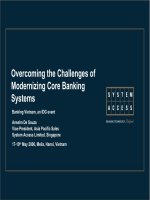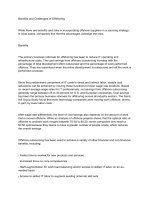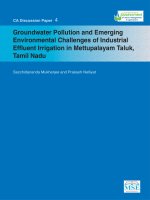Challenges of Deploying APCs
Bạn đang xem bản rút gọn của tài liệu. Xem và tải ngay bản đầy đủ của tài liệu tại đây (62.6 KB, 4 trang )
Challenges of Deploying APCs
WHITE PAPER
Passive Optical Network (PON) infrastructures deployed in fiber-to-the-premises (FTTP)
networks require numerous fiber connections to achieve the distribution of services to
multiple homes. Although splicing has its place in these systems, use of reliable angle-
polished connectors (APCs) provides numerous advantages in terms of overall network
flexibility, testing and troubleshooting.
Fiber-optic connector return-loss performance is dependent on maintaining good physical
contact between the fiber core endfaces. Any air gap created between the fiber cores
causes significant reflectance and degrades connector performance. The endface
geometry on APC connectors, however, has traditionally been difficult for manufacturers
to control since it is dependent on the outcome of the endface polishing process and
requires very tight tolerances in the manufacturing process.
ADC has made huge strides in the manufacturing process for its APCs, making them an
outstanding choice for the OSP performance and specifications dictated by PON
architectures. In particular, ADC has employed unique characteristics that enable the
control of end face geometry parameters. The critical parameters include apex offset,
radius of curvature and fiber height.
Endface Geometry’s Big Three
Controlling each of the "big three" – radius of curvature, apex offset and fiber recess – is
critical to ensuring core-to-core contact is maintained under all operating conditions for
both inside and outside plant environments.
Radius of curvature is the curvature of the ferrule endface measured immediately around
the fiber core. The apex offset is defined as the offset distance between the fiber core axis
and the apex of the radius of curvature. This measurement is critical to the performance
of APC connectors to ensure glass-to-glass contact is maintained. Preventing ferrule
rotation within the connector is the key to achieving consistently optimal contact. Fiber
height is the distance between the ferrule surface and the fiber end. Positive fiber height
is often referred to as fiber protrusion, while negative fiber height is referred to as fiber
undercut.
During connector mating, a compression of the ferrule ends occurs, creating a
deformation that enables even two undercut fibers to achieve core-to-core contact.
Manufacturers must control each endface geometry parameter to prevent performance
degradation within the connection due to poor contact. For example, if the two fiber
cores do not make physical contact, poor reflectance performance occurs.
Challenges of Deploying APCs
Challenges of Deploying APCs
Page 2
ADC adheres to the following tolerances on endface
geometry for its PC connector (SC and FC):
• Endface radius of curvature – minimum 5.0 mm;
maximum 12.0 mm
• Apex offset – minimum 0.0 microns;
maximum 50.0 microns
• Fiber height – minimum -50.0 nm;
maximum 50.0 nm
ADC developed the polishing process for the singlemode
connector using Six Sigma techniques. The results of this
study enabled ADC to achieve excellent process capability
for the three main endface geometry attributes. In this
study, the key inputs and outputs for each processing
step were clearly defined and documented. The outcome
was a very robust, cost effective, easily transferable,
patent-pending process.
Preventing Ferrule Rotation
The key to gaining a technical and competitive
advantage for connector reliability is ADC’s anti-rotational
features contained in its APC SC and LX.5 connectors.
Changing and inconsistent interfaces that allow ferrule
rotation about the ferrule axis have the potential to
create air gaps between the mated pair fiber cores,
resulting in sevice that significantly degraded, if not
interrupted.
A small ferrule rotation can change the apex offset of an
APC connector by an unacceptable amount. Therefore, it
is critical that the connector be designed to minimize this
rotation while the connector is in service. Any air gap
created by a large apex offset will increase insertion loss
and reflectance, so keeping apex offsets as low as
possible is a critical issue for high-performance
connectors.
Several industry standards address acceptable
specifications for apex offset in APC connector endface
geometry. The predominant standard is IEC-60874-14-10
which defines apex offset to be less than 50 microns in
APC connectors. Likewise, the Telcordia GR-326, Issue 3,
also specifies a 50-micron maximum apex offset. A 50-
micron apex offset, when combined with the radius and
undercut requirements of these two documents, will
achieve the required glass-to-glass physical contact in
austere environmental conditions.
How Does Apex Offset Positioning
Occur?
First, the apex offset position is set during the polishing
process. Generally speaking, ferrules have a chamfer
around the endface that is symmetric with the axis of the
ferrule. However, when polished at eight degrees, the
apex of the polished area changes with respect to the
fiber core. As more material is removed in polish, the
surface of the endface becomes relatively larger on one
side, moving the center of the ferrule endface to one
side and away from the ferrule axis.
The peak, or apex, of this radius will generally be at the
center of the surface being polished, and the distance
between the center of the fiber and the center of the
spherical surface being polished is the apex offset. As this
peak drifts away from the ferrule axis when more
material is removed, the apex offset increases.
Second, APC SC connectors are designed to enable the
ferrule to float within the connector housing. This float is
necessary because the ferrule is spring-loaded towards
the front of the connector to ensure proper mating. The
downside is that the float can allow the ferrule to rotate
about the axis of the ferrule and with respect to the
connector key. Even the tiniest rotation can lead to poor
apex offset – to a point where physical contact of the
fiber cores cannot be guaranteed.
The ferrule rotation within the connector can occur while
the connector is in service. For example, when the
connector is cleaned, a force could be applied that
causes the ferrule to rotate. Also, multiple matings can
cause the ferrule to rotate within the connector. Both
occurrences will lead to increased apex offsets that can
cause a loss of physical contact in APC SC connectors.
Forcing the Ferrule Back
ADC has developed low-rotation APC SC connectors that
correct ferrule rotation. These connectors include features
that force the ferrule back into its original position if the
ferrule is rotated either clockwise or counterclockwise
within the housing.
Forcing the connector ferrules back to their original
position (the position in which they were originally
polished) following any rotation guarantees that apex
measurements will be maintained throughout the life of
the connector. ADC’s APC SC connectors have several
patented internal features that force the ferrule into the
original non-rotated position when not mated. Without
permanent rotation, the connectors can be mated and
remated – still guaranteeing good apex offsets and
physical contact because the ferrule cannot remain in a
rotated state.
ADC Telecommunications, Inc., P.O. Box 1101, Minneapolis, Minnesota USA 55440-1101
Specifications published here are current as of the date of publication of this document. Because we are continuously
improving our products, ADC reserves the right to change specifications without prior notice. At any time, you
may verify product specifications by contacting our headquarters office in Minneapolis. ADC Telecommunications,
Inc. views its patent portfolio as an important corporate asset and vigorously enforces its patents. Products or
features contained herein may be covered by one or more U.S. or foreign patents. An Equal Opportunity Employer
1302221 09/05 Revision © 2004, 2005 ADC Telecommunications, Inc. All Rights Reserved
Web Site: www.adc.com
From North America, Call Toll Free: 1-800-366-3891 • Outside of North America: +1-952-938-8080
Fax: +1-952-917-3237 • For a listing of ADC’s global sales office locations, please refer to our web site.
WHITE PAPER









